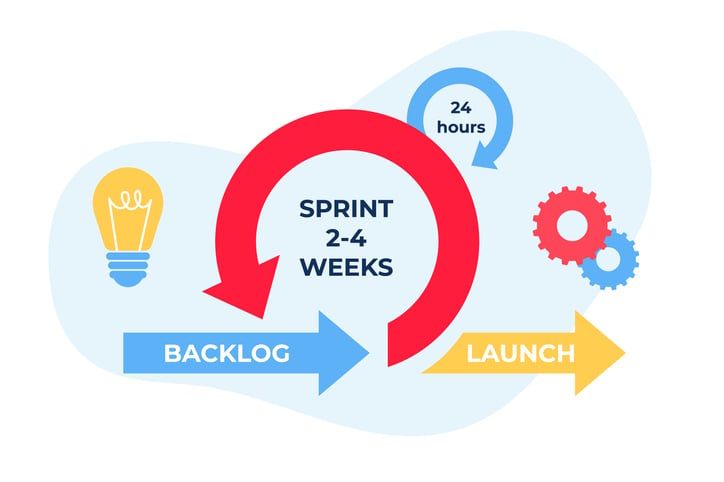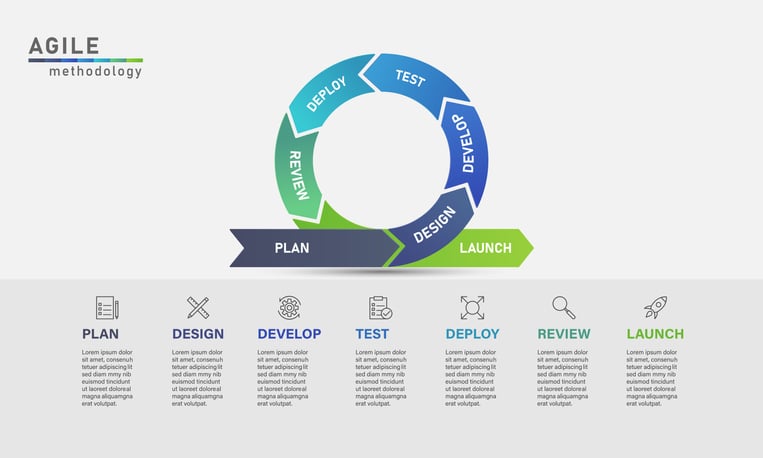
We in the manufacturing and building/construction industries know the value of lean principles, which have enabled companies, and the factories that support these companies’ production needs, to improve product quality assurance while increasing the quantity of products they can produce. For example, the Maytag Corporation’s Jackson, Tennessee dishwasher plant was able to cut work-in-process by 60%, reduced space needs by 43,000 square feet, and improved quality by 55%, while increasing capacity by 50% (the latter which resulted in their ability to switch their production mix and respond to department store demand for various models).
We’ve previously written about how lean construction, particularly about the intersection of lean construction and agile software methodologies, which have a lot of overlap from an ideological standpoint.
A closely related topic is SCRUM. Software companies and app developers alike use Scrum, a project management framework not wholly dissimilar to how some of the largest product manufacturers (e.g., from aeronautic to automobile manufacturers to manufacturers of household appliances) use lean principles as their north star, resulting in waste reduction, streamlined production timeliness, and improved outcomes.
As your company grows, you might look to hire software engineers to help assist building and managing your website and digital properties (e.g., building a company app to improve your customers’ experience, integrations between various software providers you rely on, etc.).
Knowing the different kinds of project management frameworks (in this case, SCRUM) can help owners and contractors alike understand the processes used by their multifaceted teams. What’s more, it can help them better understand and empathize with their employees and inspire the whole company to employ similar lean processes and project management frameworks that increase productivity and improve outcomes.
What’s Inside
Scrum Definition: What Is Scrum?
There are many different definitions and ways to describe the scrum framework. We’ll discuss a couple of those here.
Scrum.org notes that Scrum, also stylized SCRUM, might be thought as “the opposite of a big collection of interwoven mandatory components;” co-creators Ken Schwaber and Jeff Sutherland define Scrum in their Scrum Guide™, referring to it as “a lightweight framework that helps people, teams, and organizations generate value through adaptive solutions to complex problems.”
What does that mean, in plain English, to a layman? Software products, similar to construction projects, are massive in scale and technical complexity. Scrum ensures teams can prioritize the most important, time-sensitive deliverables in manageable working chunks, called sprints (we’ll speak to these with more specificity a little later), to ensure progress is maintained, iterated on, and improved in later sprints, rather than getting bogged down in the overwhelming details as one might as they take it on all at once.
Here’s another Scrum definition: According to Atlassian (a major software company that develops a full suite of digital tools for software developers and project managers), Scrum is “a framework that helps teams work together […encouraging] teams to learn through experiences, self-organize while working on a problem, and reflect on their wins and losses to continuously improve.”
SCRUM, they add, while “most frequently used by software development teams, its lessons can be applied to all kinds of teamwork.”
Let’s explain what they mean. Making something as seemingly simple as the frontend user interface of an app look nice but also function properly with the backend engineering necessary to process all the data is a huge technical undertaking involving a lot of specialists: The software engineers that make everything work; the UX designers that make the app, its interface, and its architecture appealing to end users based on their feedback; the QA engineers that ensure bugs are squashed, etc. Ensuring each team knows what they’re working on when helps this multifaceted group come together and deliver the product (such as a digital app) to end users and iterate on it (app updates) through continuous progress and improvement. Similarly, construction projects involve a lot of technical expertise: The architects who design the buildings; the structural engineers who lay the groundwork and ensure the structural integrity of those designs; the contractors and tradespeople who execute on those designs and build up from the foundation. Like with the Scrum example, a construction project manager or foreman instructs tradespeople of what needs to be done on a given day to ensure timelines are maintained.
Scrum Meaning and Origin
What is the meaning of Scrum? Where does the term originate from? Scrum is a term bowered from rugby, short for scrummage; in rugby football (aka, English football), a scrummage is a method of restarting play involving players packing closely together with their heads down in an attempt to regain possession of the ball.

The term scrimmage, or the line of scrimmage, describes the North American football (aka, gridiron football) equivalent, an “imaginary transverse line (across the width of the field) beyond which a team cannot cross until the next play has begun.”
SCRUM Benefits
SCRUM benefits, as Tech Target notes, include:
- Clearly defined goals
- Flexibility to allow quick product (or in a contractor’s case, project) changes
- Tested, stable products
- Productive meetings
- Timely feedback loops
- On-time delivery
- Team growth
- Reduced risk
- Higher ROI
SCRUM Process: Unpacking the Scrum Framework
Why, pray tell, would anyone consider using the Scrum framework (or its equivalent in our industry)?

Mike Judge’s Silicon Valley gives perhaps the most precise, exacting justification for using Scrum. In the below clip, two software engineers, Dinesh Chugtai and Bertram Gilfoyle, employed at the fictional startup company, Pied Piper, come to the untimely realization that they have completed the same work as one another.
Pied Piper’s business manager Jared Dunn, portrayed by actor Zach Woods, relays to the company’s CEO, Richard Hendrix, that, had they used Scrum, both Dinesh and Gilfoyle would have known exactly what they were supposed to be working on, eliminating any risk of redundant double work and lost productivity.
Within the construction framework (especially among teams with limited resources), this is precisely why construction integrations are key, and why we are committed to building them and working with contractors to identify solutions for their construction data problems. Connecting, for example, your inventory app to your project management app, or to your BIM platform, helps reduce manual inputs and double work; when multiple teams are working on the same projects, why not feed the same project data to each platform rather than having to create a new project and its associated project details in each platform?
As a quick, tangential aside: Our team particularly appreciates that it’s an M18 FUEL™ Drill/Driver Gilfoyle wields in hand when he needs to “fix” an errant external hard drive Dinesh mistakenly sells containing sensitive IP.
Scrum Workflow
Typically, Scrum follows sprints, also known as an iteration or timebox, a basic unit of development for which the length is agreed and fixed in advance, typically between one week and a month, though two weeks is the most common.

Sprints ordinarily involve the following components:
- Sprint Planning: The sprint goal is decided and agreed upon.
- Daily Scrum: A daily standup/touch-base in which progress is reported and risks/impediments are identified and mediated.
- Sprint Review: Conducted at the end of the sprint, the team “demos” completed work with stakeholders to elicit feedback and receive suggestions for upcoming work.
- Sprint Retrospective: The team looks inward toward self-improvement, seeking the answers to questions like: “What went well during the sprint? What did not go well? What could we do differently next sprint?”
- Backlog Refinement, also known as grooming, the backlog is reviewed in order to determine which items can be broken into smaller ones, which acceptance criteria needs clarification, which dependencies need to be investigated, any priorities that may have changed, etc.
Construction projects, on the other hand, may be planned out months or years in advance, with many dependencies such as architectural drawings, city ordinances and approvals, financing, etc. determining when you may break ground, while other dependencies (such as inclement weather) may impact timelines and risk project overruns. While these dependencies and unforeseen circumstances loom large, making the comparison to 2-week software development seem moot, the underlying philosophy of putting the customer first and continuous process improvement is likely common ground.

Where construction teams are increasingly strapped, forced to think how they might do more with less, solutions for questions like “Were we understaffed during our last project? Have we been consistently missing deadlines? Are weather conditions making us lose valuable working days?” may start to surface:
- Can we pursue offsite construction methods (such as prefab construction, modular construction, construction 3D printing) to maintain deadlines, improve quality assurance, and meet hard deadlines?
- Can we implement the design-build process to streamline projects and reduce the time it takes from initial design to construction by bringing the process in house?
- Can our tradespeople use smart tools to deliver installs faster, safer (see antikickback control), and with proper documentation to cover any liability issues raised? Can we use construction robots to automate time-consuming and dangerous tasks? Can we use construction drones to maintain visibility to the jobsite and get real-time progress updates?
- Can we use an inventory app (and associated hardware; e.g., asset ID tags, Bluetooth® tags, GPS trackers, etc.) to help solve our labor shortages by maintaining better visibility to equipment and limiting equipment downtime? E.g., optimizing our supply chain, safety stock, and on-the-job work (i.e., using “just-in-time” inventory management when sending items to the job)
Scrum Team
The typical Scrum team consists of the following:
- Product owner: The product serves as the product’s stakeholder and the voice of the customer, responsible for delivering good business results. Within a construction project, the closest equivalent to software product owner would be a construction company’s owner/CEO or, in smaller teams, an independent general contractor who may own his or her own business and employ subcontractors and trades. Based on business priorities, software product owners maintain the product backlog and write user stories (i.e., descriptions of features of a software system), just as a construction owner may determine which projects are feasible based on a backlog of current inflight projects.
- Developers: Software developers (e.g., researchers, architects, designers, data specialists, statisticians, analysts, engineers, testers, etc.) carry out the work required to build features laid out in each sprint. The “developer” role within a construction project might include the design team (architects, BIM specialists, GIS specialists, etc.), individual tradespeople working on the job and delivering on those designs, etc.
- Scrum master: The Scrum master is accountable for removing impediments in order to deliver the product goal and deliverables. In construction, the scrum master might be a construction foreman or project manager.
SCRUM vs Agile: What’s the Difference?
The terms SCRUM and agile are often uttered in the same breath. That’s because SCRUM project management is one of the most popular Agile software methodologies used among project managers. In fact, of those surveyed, 94% reported using Scrum in their Agile process.

As Associate Teaching Professor in Northeastern University’s Master’s in Project Management puts it, “Whereas Agile is a philosophy or orientation, Scrum is a specific methodology for how one manages a project […] IT provides a process to identify the work, who will do the work, how it will be done, and when it will be completed by.”
Northeastern University notes the differences between Agile and Scrum are that:
- Agile is a philosophy, whereas Scrum is a type of Agile methodology.
- Scrum is broken down into shorter sprints and smaller deliverables, while in Agile everything is delivered at the end of the project.
- Agile involves members from various cross-functional teams, while a Scrum project team includes specific roles, such as Scrum Master and Product Owner.
In this regard, construction companies and contractors interested in lean manufacturing principles may most closely resemble that of the Agile methodology, as we’ve previously discussed, delivering final projects to customers, though they may look to Scrum to understand how they might segment construction deliverables on an ongoing basis.
SCRUM vs Kanban
Kanban, according to Atlassian, is a popular framework used to implement Agile and DevOps software development, where work items are represented visually on a Kanban board that allows team members to see the state of every piece of work at any time.

Atlassian notes, of the differences between Scrum and Kanban, “is a discussion about two different strategies for implementing an agile development or project management system [… Kanban methodologies are continuous and more fluid, whereas scrum is based on short, structured work sprints.” Further, Northeastern University adds, “A key difference between Kanban and other Agile methodologies, such as Scrum, is that there are typically limitations regarding how many tasks can be in progress at once. Project management teams will typically assign a specific number of tasks to each column on the board, which means that new tasks cannot begin until others have been completed.”
Bottom Line
64% expect more project starts & backlogs. Labor shortages continue to be a problem, while more work multiplies. Understanding how you can be organizationally lean is more important than ever.
With that in mind, understanding what Scrum, and other project management frameworks, mean in business can help construction owners understand the processes of their employees (as well as other industries) and help them better collaborate and share knowledge and lean processes that help the entire company work better together, increase productivity, and improve outcomes.